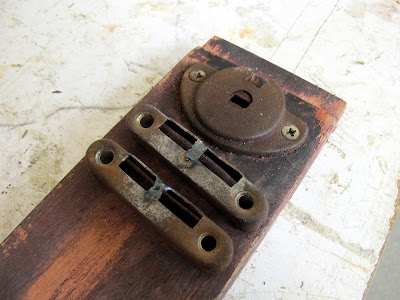My neighbor the antique dealer brought over one of his typical jobs this weekend. It usually involves some metal bit that has seen some kind of mechanical injustice and or application of brute force.Its a wonder how these things manage to make it to the future in such good shape. Its a testament to the people that designed and built some of these things.
This repair involved a cleverly designed sheet metal bracket that allows the legs of a antique Foosball table to be easily removable for shipping. Fortunately for me there was a second bracket mating bracket that was in reasonable shape so I could see what had to happen. The bracket is steel, and about 1mm thick. It is a deep drawn and pierced shape which is interesting all by itself. I would be interested to see the die that produced this particular piece. It always amazes me the work behind the scenes to get a product to market. This table might be fifty or more years old. Some old guy designed a drawing die that some long dead draftsman faithfully drew up to his instructions which then went out to the machine shop to be built. All this for one little hidden bracket of many similar parts on this obscure leisure game.
If you are interested in this work there is much to be learned from the folks that have gone before us. I always tell my students to be curious and study existing common items. One of the most fascinating things I ever did was to take a run of the mill household washer and dryer apart and study the parts in detail. That experience is for another post but it was highly educational and eye opening from the mechanical design perspective.
So the little trashed bracket in the first picture is supposed to mate with this nifty rotary locking device. When the cross brace is installed a flat blade screwdriver rotates a tapered scroll that pulls the assembly together into a tight wiggle free joint. Its worth studying here because in practice easily assembly and tight fits don't always work out with easy to manufacture loose tolerance parts. The competing needs of cost, tolerances, and simplicity make a joint like this a little design challenge.
Here you see the one good bracket installed into the rotary locking device and snugged up. Another subtle design point is the little barbs you see at the top of the picture which help to lock the bracket into the wood. These are part of the die work that some engineer thought of way back when and included in the stamping. If your going to make a production tool to make something like this in quantity then by all means get all the features you want included right from the start.The initial die cost is higher but it pays you back with every part that comes off the tool.
Using smooth jawed pliers and some careful hammer and punch work I was able to straighten the damaged bracket. It became apparent that the one I initially thought was good turned out to be missing a small bit of material in a pretty important area. Between the two brackets I was able to see all the features of a perfect bracket.
Fortunately for me the material was steel so I carefully TIG welded the cracks and added some missing material to complete the job.So a fun little repair job and a happy neighbor. I probably raised the value of the this Foosball table thirty percent just by a simple repair.
Too many things get thrown out for the want of a simple repair. In this case it was an "antique" with some perceived value just because time has taken it out of context. I submit that we throw away too many items that could be easily fixed but we are just to lazy to lift the hood and have a look.Move them forward in time fifty years and now they are cool old vintage items that people pay three times what they cost new just to put them in a curio cabinet.
Doing my part to repair and recycle I have rescued several very nice space heaters from the scrap metal hoppers. This particular model has a built in tilt switch that in the event the heater tips over it cuts the current so it wont inadvertently start a fire. When they do get kicked or tipped over the little safety switch does its job and breaks the electrical circuit. Depending how hard it got knocked over can mean the switch gets stuck in the open position. Kind of a fail safe type design. Incidentally trying to design something to fail in a particular and very specific way is a pretty tough job.
I was curious why so many of these nice heaters were ending up in the dumpsters. Curious Tom opened one up that didn't pass the onoff test to see what was going on. Low and behold the little safety switch was jammed in the open position. A little tweak with a screwdriver and wham-mo it works again.
Moral of the story is, be curious and lift the skirts and open the hoods of your mechanical contraptions. You might get a pleasant surprise.




No comments:
Post a Comment